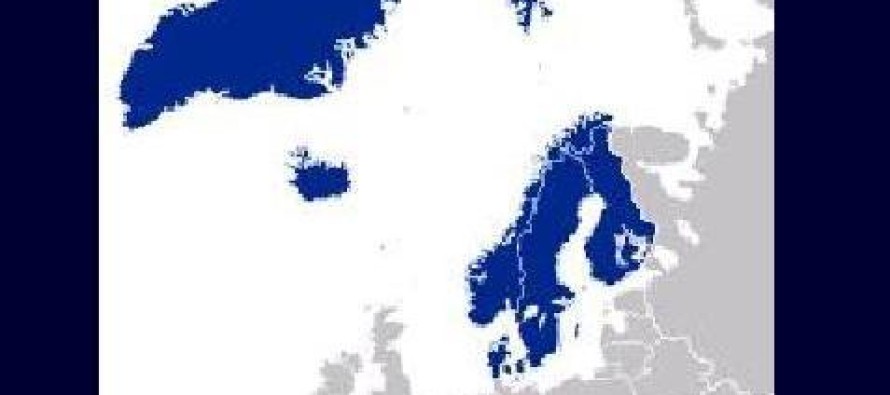
NordenBladet

Welcome to NordenBladet — the comprehensive business directory & internationally recognized leading channel of Nordic and Scandinavian information, news, media, entertainment, events and services. Serving Norway, Sweden, Denmark, Finland, Iceland, Faroe Islands, Greenland and Åland.
Enter to NordenBladet:
Find NordenBladet in Facebook


About The Nordic Coutnties
The Nordic countries make up a region in Northern Europe and the North Atlantic which consists of Denmark, Finland, Iceland, Norway and Sweden and their associated territories, the Faroe Islands, Greenland and Åland. In English, Scandinavia is sometimes used as a synonym for the Nordic countries (but excluding Greenland), despite the fact that that word is most strictly defined to refer only to Denmark, Norway and Sweden.
The region’s five nation-states and three autonomous regions share much common history as well as common traits in their respective societies, such as political systems and the Nordic model. Politically, Nordic countries do not form a separate entity, but they co-operate in the Nordic Council. The Nordic countries have a combined population of approximately 25 million spread over a land area of 3.5 million km² (Greenland accounts for around 60% of the total area).
Although the area is linguistically heterogeneous, with three unrelated language groups, the common linguistic heritage is one of the factors making up the Nordic identity. The continental Scandinavian languages – Danish, Norwegian and Swedish – are considered mutually intelligible. These languages are taught in school throughout the Nordic countries; Swedish, for example, is a mandatory subject in Finnish schools, whereas Danish is mandatory in Icelandic, Faroese and Greenlandic schools. Besides these and the insular North Germanic languages Faroese and Icelandic, all belonging to the Indo-European language group, there are the Finnic and Sami branches of the Uralic languages, spoken respectively in northern Norway, Sweden, Finland and Estonia, and Greenlandic, an Eskimo–Aleut language, spoken in Greenland.
The term ‘Nordic countries’ is derived from the French term Pays nordiques as an equivalent of the local terms Norden (Scandinavian languages), Pohjola / Pohjoismaat (Finnish language), Põhjala / Põhjamaad (Estonian language), Norðurlönd (Icelandic), Norðurlond (Faroese) and Davveriikkat (North Sámi) with the meaning of “The North(ern lands)”.
In English usage, the term Scandinavia is sometimes used—though not consistently—as a synonym for the Nordic countries. From the 1850s, Scandinavia was considered to include politically and culturally, Denmark, Norway, and Sweden. Geographically, the Scandinavian Peninsula includes mainland Sweden and mainland Norway, and also a part of Finland, while the Jutland Peninsula includes mainland Denmark and a small part of Germany. Denmark proper has not included any territory on the Scandinavian Peninsula since 1658. The Faroe Islands and Iceland are “Scandinavian” in the sense that they were settled by Scandinavians and speak Scandinavian languages, but geographically they are not part of Scandinavia. Having once been a part of Sweden, Finland has been significantly influenced by Swedish culture and part of it is geographically within Scandinavia, whereas the Finnish language is not related to the Scandinavian languages. Greenland was settled by the Norse, and is currently part of the Danish realm, with the Danish language spoken by nearly all inhabitants, while geographically it is part of North America.
In geology, the term for the land area which lies above sea level on the Baltic shield (also known as the Fennoscandian Shield) is Fennoscandia (from the Latin toponyms Fennia and Scania).
Merriam-Webster Online Dictionary defines “Nordic” as an adjective dated to 1898 with the meaning “of or relating to the Germanic peoples of northern Europe and especially of Scandinavia” or “of or relating to a group or physical type of the Caucasian race characterized by tall stature, long head, light skin and hair, and blue eyes”. Before the 19th century and romantic nationalism, the term Nordic may have been used more as a synonym for Northern to mean Northern Europe including the Baltic countries (at that time Lithuania, Livonia and Courland) and occasionally the British Isles and other lands on the shores of the Baltic and North Seas.
While the term Scandinavia is commonly used for Denmark, Norway and Sweden, the term the Nordic countries is used unambiguously for Denmark, Norway, Sweden, Finland, and Iceland, including their associated territories (Greenland, the Faroe Islands, and the Åland Islands). Scandinavia can thus be considered a subset of the Nordic countries. Furthermore, the term Fennoscandia refers to Scandinavia, Finland and Karelia, excluding Denmark and overseas territories; however, the usage of this term is restricted to geology, when speaking of the Fennoscandian Shield (Baltic Shield).

 High quality & nature friendly luxury cosmetics from Scandinavia - ElishevaShoshana.com
High quality & nature friendly luxury cosmetics from Scandinavia - ElishevaShoshana.com


